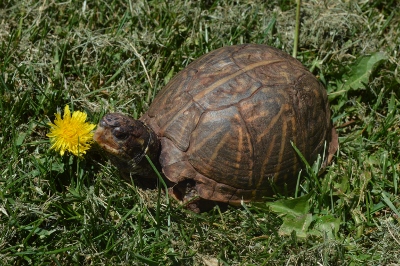
Slowly but surely, the box tortoise is stepping out of the spotlight to make way for a new Animal of the Month. We hope you enjoyed our tweets @ExoticPetVets throughout May about these popular reptiles. In case you missed any of tweets, here is a summary. Did you know?:
- Box tortoises (Terrapene carolina) are a group of tortoises with six subspecies.
- Differences between the subspecies can be seen in the patterns and colours of the box tortoise’s upper shell.
- Box tortoises can be found in different regions of the United States and Mexico, depending on the subspecies.
- Box tortoises are also commonly known as box turtles.
- The box tortoise has a high-domed upper shell, which is called the carapace.
- The high-domed shell shape aids in thermal regulation, an evolutionary trait that prevents box tortoises from overheating.
- The box tortoise’s lower shell is called the plastron.
- The plastron is hinged which allows the box tortoise to tightly close her shell to protect her from predators.
- The box tortoise’s shell is covered with bony plates called scutes, which shed in large patches.
- The activity rate of the cold-blooded box tortoise is determined by her environmental temperature.
- The box tortoise’s preferred body temperature is 37.8 degrees Celsius (100 degrees F).
- If it’s too hot in the summer, wild box tortoises will typically restrict their activity to the morning hours.
- In the wild, most box tortoises will try to hibernate. Hibernation in reptiles is also known as brumation.
- In captivity, it’s unnecessary for box tortoises to hibernate if the tank is warm and the lights are on 12-14 hours a day.
- Some people want their box tortoises to hibernate but they must speak to a reptile vet first and provide ideal conditions.
- “Pseudohibernation” is a problem where the constant ambient temperature is too warm – above 16 degrees C (61 degrees F).
- In pseudohibernation box tortoises appear to be hibernating but their metabolism is too high and they’re slowly starving.
- In captivity only healthy box tortoises should be allowed to hibernate under the care of experienced reptile owners.
- Wild box tortoises absorb ultra-violet A and B (UVA and UVB) light from basking in the sun. It gives them vitamin D3.
- UVA light provides box tortoises with the heat they need for healthy overall function. UVB light gives them vitamin D3.
- In captivity, box tortoises need special bulbs to provide them with UVA and UVB light.
- Box tortoises need UVB light for calcium absorption, otherwise they can develop metabolic bone disease.
- Metabolic bone disease can lead to shell deformations, growth problems, poor health and death in box tortoises.
- Box tortoises don’t usually grow very big, reaching an average adult diameter of about 5-7 inches (about 12-17 cms).
- In captivity, box tortoises reach adult size between 4-6 years of age if they’re cared for properly.
- With proper care, box tortoises in captivity can live 20 years or more.
- Box tortoises are omnivorous, meaning they eat both plant and animal material, such as insects and frogs.
- In captivity, a box tortoise diet should be 50% plant-based food and 50% animal-based food.
- Of the plant-based food given to captive box tortoises, 80-90% should be veggies + flowers. Only 10-20% should be fruits.
- All turtles, including box tortoises, are commonly blamed for Salmonella bacterial infections in children.
- Due to concerns about the Salmonella bacterium, it’s important to wash your hands after handling any turtle or tortoise.

